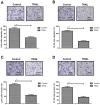Tumor necrosis factor-related apoptosis-inducing ligand inhibits the growth and aggressiveness of colon carcinoma via the exogenous apoptosis signaling pathway
- PMID: 30651763
- PMCID: PMC6307519
- DOI: 10.3892/etm.2018.6901
Tumor necrosis factor-related apoptosis-inducing ligand inhibits the growth and aggressiveness of colon carcinoma via the exogenous apoptosis signaling pathway
Abstract
Colon cancer is one of the most common types of gastrointestinal tumor. Previous studies have demonstrated that tumor necrosis factor-(TNF)-related apoptosis-inducing ligand (TRAIL) reduces the aggressiveness of colon cancer tumors and promotes the apoptosis of colon carcinoma cells. In the present study, the inhibitory effects of TRAIL were investigated and the potential mechanism of TRAIL-mediated apoptosis was explored in colon cancer cells. Reverse transcription-quantitative polymerase chain reaction, western blotting, immunofluorescence, immunohistochemistry, TUNEL and flow cytometry assays were used to analyze the effects of TRAIL on the growth, migration, invasion and apoptosis of colon tumor cells. In vivo experiments were performed in mice to analyze the therapeutic effects of TRAIL. The results demonstrated that TRAIL significantly suppressed the growth of colorectal tumor cells in a dose-dependent manner (0.5-2.5 mg/ml) and also promoted colon tumor cell death. The migration and invasion of colon tumor cells were inhibited by the downregulation of fibronectin, Vimentin and E-cadherin. The apoptotic rate revealed that TRAIL (2.0 mg/ml) significantly promoted the apoptosis of colon tumor cells by regulating apoptosis-related gene expression. TRAIL administration promoted the apoptosis of colon tumor cells via the exogenous apoptosis signaling pathway due to the upregulation of caspase-3, caspase-8 and nuclear factor-κB protein expression. In vivo assays revealed that TRAIL administration significantly inhibited tumor growth and promoted apoptotic body and lymphocyte infiltration, which led to increased survival in tumor-bearing mice compared with the control group. Immunohistochemistry revealed that P53 and B-cell lymphoma-2 were downregulated in TRAIL-treated tumors. In conclusion, TRAIL treatment significantly inhibited the growth and aggressiveness of colon tumors by inducing apoptosis via the exogenous apoptosis pathway, which suggests that TRAIL may be a potential anticancer agent for colon carcinoma therapy.
Keywords: aggressiveness; apoptosis; colon cancer; exogenous apoptosis pathway; tumor necrosis factor-related apoptosis-inducing ligand.
Figures








Similar articles
-
Tumor suppressor XIAP-Associated factor 1 (XAF1) cooperates with tumor necrosis factor-related apoptosis-inducing ligand to suppress colon cancer growth and trigger tumor regression.Cancer. 2010 Mar 1;116(5):1252-63. doi: 10.1002/cncr.24814. Cancer. 2010. PMID: 20082449
-
The synergistic effects of low-dose irinotecan and TRAIL on TRAIL-resistant HT-29 colon carcinoma in vitro and in vivo.Int J Mol Med. 2012 Nov;30(5):1087-94. doi: 10.3892/ijmm.2012.1105. Epub 2012 Aug 21. Int J Mol Med. 2012. PMID: 22922573
-
Tumor necrosis factor-related apoptosis-inducing ligand additive with Iodine-131 of inhibits non-small cell lung cancer cells through promoting apoptosis.Oncol Lett. 2018 Jul;16(1):276-284. doi: 10.3892/ol.2018.8635. Epub 2018 May 4. Oncol Lett. 2018. PMID: 29928412 Free PMC article.
-
TRAIL inhibits platelet-induced colorectal cancer cell invasion.J Int Med Res. 2019 Feb;47(2):962-972. doi: 10.1177/0300060518820785. Epub 2019 Jan 9. J Int Med Res. 2019. PMID: 30621488 Free PMC article.
-
The Role of TRAIL Signaling in Cancer: Searching for New Therapeutic Strategies.Biology (Basel). 2024 Jul 15;13(7):521. doi: 10.3390/biology13070521. Biology (Basel). 2024. PMID: 39056714 Free PMC article. Review.
Cited by
-
Identification of Immune-Related lncRNA Pairs and Construction and Validation of a New Prognostic Signature of Colon Cancer.Can J Gastroenterol Hepatol. 2022 Mar 30;2022:5827544. doi: 10.1155/2022/5827544. eCollection 2022. Can J Gastroenterol Hepatol. 2022. PMID: 35399646 Free PMC article.
-
CXCR4 enhances the inhibitory effects of bone mesenchymal stem cells on lung cell apoptosis in a rat model of smoking-induced COPD.Apoptosis. 2023 Apr;28(3-4):639-652. doi: 10.1007/s10495-022-01800-6. Epub 2023 Jan 31. Apoptosis. 2023. PMID: 36719470 Free PMC article.
-
Assessing causal associations between TNF-related apoptosis-inducing ligand, vascular endothelial growth factor and colon cancer: a Mendelian-randomization study.Discov Oncol. 2025 Jun 18;16(1):1146. doi: 10.1007/s12672-025-02864-x. Discov Oncol. 2025. PMID: 40531284 Free PMC article.
-
Role of phloretin as a sensitizer to TRAIL-induced apoptosis in colon cancer.Oncol Lett. 2022 Jul 19;24(3):321. doi: 10.3892/ol.2022.13441. eCollection 2022 Sep. Oncol Lett. 2022. PMID: 35949608 Free PMC article.
-
Low extracellular pH enhances TRAIL-induced apoptosis by downregulating Mcl-1 expression.Exp Cell Res. 2025 Apr 1;447(1):114481. doi: 10.1016/j.yexcr.2025.114481. Epub 2025 Feb 28. Exp Cell Res. 2025. PMID: 40024506
References
-
- Tudyka V, Blomqvist L, Beets-Tan RG, Boelens PG, Valentini V, van de Velde CJ, Dieguez A, Brown G. EURECCA consensus conference highlights about colon & rectal cancer multidisciplinary management: The radiology experts review. Eur J Surg Oncol. 2014;40:469–475. doi: 10.1016/j.ejso.2013.10.029. - DOI - PubMed
-
- Sheets N, Powers J, Richmond B. Cutaneous metastasis of colon cancer: Case report and literature review. W V Med J. 2014;110:22–24. - PubMed
LinkOut - more resources
Full Text Sources
Research Materials
Miscellaneous
